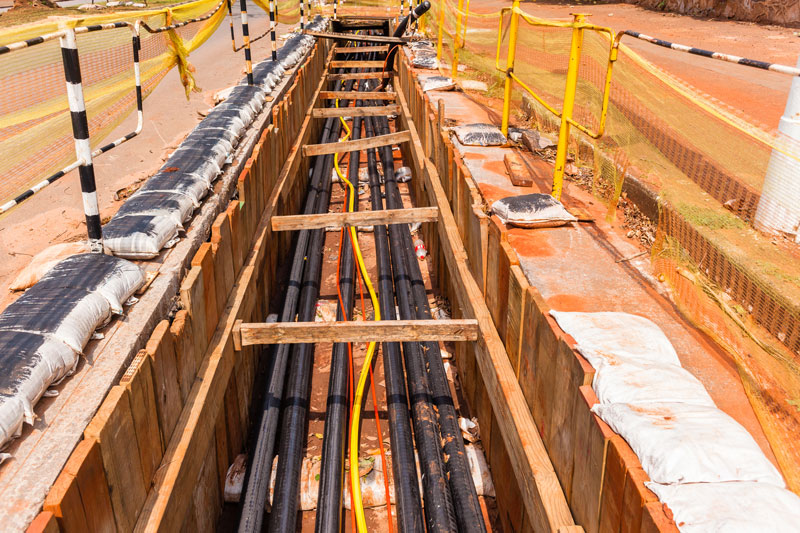What Actually, is ROW?

You’ve heard me ask “Am I Doing This Right?” when it comes to the struggles any young professional could face. But now I’m also going to be asking a new question: What Actually, does this mean?
You see, I was not an engineering major. Shocking, I know. I was a Communication major, and spent my elective time learning about Norwegian culture, evolutionary psychology, and literature. Want to hear about the inoculation theory for persuasion? I’ve got you covered! GIS, LiDAR, and SUE? I’m working on it. I am very proud of how far I’ve come in my journey to understand all this engineering jargon, so I thought I’d include you on it! Together, we will learn about a range of industry topics, from basic concepts to full blown services, and what it all actually means.
We’re starting out with an acronym I’d heard for years before understanding what it meant: ROW.
What’s ROW?
When I was growing up, my house was on the corner of the street. For years, we didn’t have a street sign on our property. Then one day, when I was about fourteen, one appeared. My dad was annoyed that he would have to mow around it, and even though it was our yard, we had no say about the street sign’s sudden appearance. At the time I didn’t understand how that could be, but I also was not the one mowing so I really didn’t give it a second thought.
Now, I understand that Right-of-Way, or ROW as we say it in the biz, is the reason that street sign could be installed on our corner. The Department of Transportation (DoT) actually owns a few feet beyond the streets themselves (and in the case of major highways they can own a lot more than a few feet), which is how public sidewalks and street signs are able to exist. If you’re new to the world of ROW and land usage rights, think projects which benefit the good of the community like highways, railways, electrical transmission lines, and oil and gas pipelines. And how sometimes these projects require use of land that may involve private property owners. Are you with me?
What Do Our ROW Land Agents Do?
Our land agents act as a liaison between who they’re working for (usually the DoT, but sometimes another entity) and the general public. Their job is often to confirm there is adequate access for the landowner’s specific needs or actually acquire ROW easements. What does that really mean?

When an entity requires land to construct a project, they will often rely on land agents to help acquire it. Land agents support the efforts of the entity by actually acquiring the land needed for the project and it’s their job to communicate with the public. This can be tricky business.
That being said, our land agents make an effort to be mindful in listening to everything the property owner has to say so they can accurately understand and address all concerns. It’s their job to remain as professional as possible when communicating the details of the project, and to be as clear and helpful as possible too, while always remembering that our professionalism will reflect on our client.
The Most Common ROW Problems
Thinking back to my dad and that street sign, I am struck with the memory of how truly annoyed he was at having to take care of the grass differently than he was used to with this sign in his way. This is a great example of why public perception is often the hardest part of any project involving ROW. Entities use the ROW land for things that end up being overwhelmingly good for the overall community such as sidewalks, utilities, to widen the road, add streetlights, traffic signals, and street parking. But people understandably don’t love being told that someone else is going to come and make a change to their property.
When working on a project, we consider location, time of year, and other unique features of each project. Some projects have accelerated schedules and stricter budgets than others. But, all require extremely diligent project pre-planning and early site visits. Projects may also have challenges with title searches. These include public record errors, bankruptcy/foreclosures, missing heirs or numerous heirs to a property, undiscovered wills, liens and/or mortgages that require releases, etc. Each jurisdiction has its own requirements. So, our team must also have a thorough understanding of each one we work in. We observe field conditions and find a critical path to create plans that are feasible from a ROW perspective. Of course, this is done as early as possible in the project process.
Got it?
Ok, so are you with me? Right-of-Way (ROW) is the legal right of one to cross the property of another. Usually granted in the form of a permanent lineal strip of land, often resulting in the convergence of public and private property. ROW projects require land agents, which is where we come in. They smooth out the process for both our client and the community. Capiche?
Want to learn more about the challenges I mentioned? Check out my other ROW blog here.
And I’ll catch ya next time I ask, What Actually?

Comments are closed.